Busting a Cheetah Skin Seller: South Africa
As seen in my ongoing reports on National Geographic News Watch & click here for Interview with Annie Beckhelling during the operation.
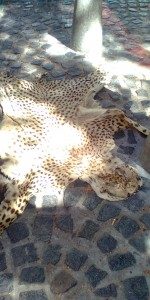
The seller laid the skin out for me to examine
Cape Town, South Africa, December 21, 2011 — I have just returned from a 9-day trip through the remote North West Province and the Karoo in the Eastern Cape. It is my day off and I fully intend to do nothing other than stroll around beautiful Cape Town without purpose.
In famous Greenmarket Square, while buying some gifts for friends back home, I notice a seller has something that looks like a spotted skin. I can’t believe the sight; it lies under a pile of springbok skins, but in full view. I ask the seller what it is and he replies with a big grin,
It’s a leopard!”
“No, this isn’t a leopard it’s a cheetah.” “No it’s a LEOPARD.”

The seller tried to convince me this is a leopard, but after some discussion he admitted it is indeed a cheetah.
We go back and forth like this for a minute and I finally ask him to unfold the skin so I can see it better. He places it on the cobblestones and I pick up the face and show him the tear-marks. “You know this is a cheetah”. “How do you know it’s a cheetah?” He is starting to get irate, but he is still smiling. I ask him where it’s from. “It’s a secret,” he says, and then he tries to sell it to me for 6000 rand (U.S.$740). The shoulders are ripped and I ask who would buy such a thing in bad condition. He tells me that traditional medicine men will come to the market and buy it from him. “For what?” “I’m not a bush doctor, I do not know.”
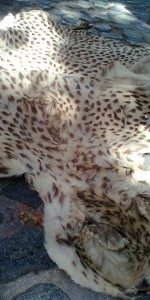
The selling without a permit of any spotted cat skin is illegal in South Africa
At this point I decide to leave and figure out what I should do. I flirt and smile with the seller a little more and wave goodbye. After walking a few blocks I find two officers from CCID who are greatly concerned but unsure of what steps to take. We talk to two police officers sitting at a table in the Wimpy’s fast food restaurant. One of the officers laughs at me, the other looks with a blank stare and nothing to say on the matter. The CCID officers realize they don’t know what to do either and decide to radio more police that could possibly help. After more waiting, the police radio them back, refuse to show up and state that the seller is allowed to have the skin.
Clearly nothing is going to be done and my contacts with conservation will have a better idea. I thank the officers for their genuine concern and attempt to assist, and return to my office to write some emails.
Within minutes of sending a concerned email to every person I could think to help, including the Cape Town Mayor’s office, a friend in Johannesburg messaged back to call Annie Beckhelling, the founder of Cheetah Outreach, immediately. By 10:30 pm, Annie has a plan. We will meet at the hotel on Greenmarket Square in the morning, she will bring her film crew from The Cheetah Diaries and alert Cape Nature as well as the proper police department for rapid response.
According to the Endangered Wildlife Trust:
“Cheetahs and leopards are both protected under our National legislation the National Environmental Management Biodiversity Act 10 of 2004 (NEMBA) and the Threatened or Protected Species Regulations of 2007 (ToPS). In accordance with this legislation permits are required to possess and sell any product or live specimen of any listed species which therefore includes cheetahs and leopard. Unfortunately this legislation is currently not implemented in the Western Cape Province.”
Morning, December 22, 2011: Annie is a presence, arriving with a security guard, and decked head to toe in leopard print, elegant jewelry and not a hair out of place. I feel instantly frumpy in my bush clothes and ponytail. She sits down and takes charge, strategizes how the day will go down, what laws have been broken, where the skin most likely came from and how our on-camera interview will proceed.
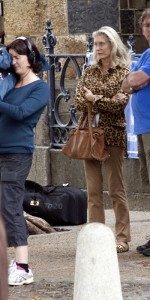
Annie Beckhelling and The Cheetah Diaries film crew observe as Cape Nature reps confiscate and gather information.
After our interview, Annie and her security guard take a stroll through the market to the stall I pointed out and discover the skin is still there, out in the open. I stay behind, to give information but not show my face so the sellers do not catch on to what is about to happen. They find the skin right where it was yesterday and return to the hotel café where we call Cape Nature to confirm and await their arrival.
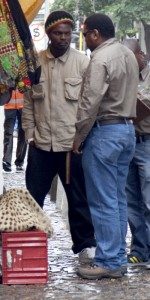
With the skin in full view, Cape Nature’s Biodiversity Crime Unit talks with the stall keeper
True to African time, 4 hours roll by as we wait for Cape Nature, “30 minutes away”. At last they arrive and thankfully the skin is still there. The two reps approach, confiscate the skin and start taking information. The police step in to assist in gathering information on the seller. The owner of the stall is not there, only a shop worker. This is the last man in the long chain of the sad journey of this cheetah’s life. What happens now? The stall owner’s information, home address, phone number and stall number is taken and a court hearing is expected to occur.
The latest update from Cape Nature’s Biodiversity Crime Unit as of January 11, 2012, is the stall owner claims the skin is not hers and she was selling it for someone else. Cape Nature is in the early stages of investigating charges, continuing this investigation, and there will be regular follow up as new evidence develops.
How does one work backwards in the chain of poaching? Is this a dangerous endeavor? I myself do not know, and am saddened this even occurred, but proud of the hard work of a dedicated group of people to act within 36 hours during the hectic holiday season in South Africa.
Feel free to express in the comments should you like to let these government agencies know the global community is watching, concerned and taking notes on the effectiveness of implementing these existing laws.
The Cheetah Diaries will also be posting a clip from the bust on their website as well as featuring the story in Season Three. My next post will link to their follow-ups.
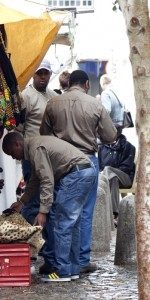
The cheetah skin is confiscated and removed from the stall
All images and video: Marcy Mendelson
More on Cheetah Outreach:
“In January 1997, founder Annie Beckhelling, launched the project with a hectare of land provided by Spier Wine Estates located in Stellenbosch, South Africa. Cheetah Outreach then set out to introduce cheetah to the South African community.”
Cheetah Outreach is continually evolving and taking on new challenges. In addition to partnering with ambassador cats to inform the public about the problems the cheetah faces, Cheetah Outreach:
- Continues to be involved in environmental education, offering curriculum-linked school presentations and resources as well as workshops and fellowships for teachers.
- Breeds Turkish Anatolian Shepherd dogs and places them on South African farms to guard livestock in an effort to reduce conflict between farmers and predators.
- Hand-rears cubs from the Ann van Dyk Cheetah Centre and raises them to be ambassadors for the species.
- Partners with other cheetah conservation organizations worldwide.
The views expressed in this guest blog post are those of Marcy Mendelson, a freelance photographer working with NGOs involved with the conservation of cheetahs, and not necessarily the views of the National Geographic Society.

This makes me so sad that some ‘authorities’ didn’t understand the importance of acting on your information about the cheetah skin. Also that the stall shop keeper thought it was better to tell you the skin was leopard…
This is disgusting. Killing any animal for fur is disgusting but to kill and skin a big cat that is rare, is the saddest and most wrong action of all. It is pointless. No one NEEDS a cat skin rug or wall hangin
Hi,
On this article you clarify quite a few of the more significant views.
. Really easy to browse and full of practical
insights..
Thanks a lot for posting Busting a Cheetah Skin Seller: South Africa | Cheetah-Watch…
I never can believe people do something like that. And he lied and said it was leopard! This is what makes me lose faith in the human race-but you guys help me regain it.